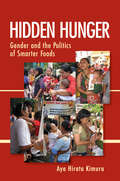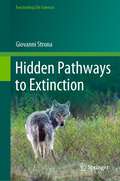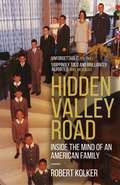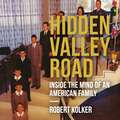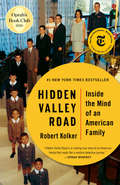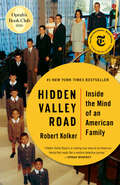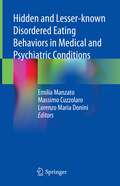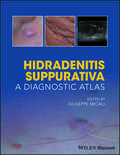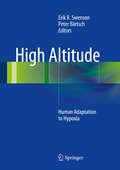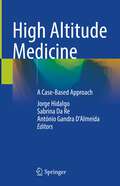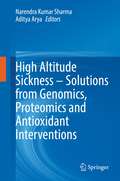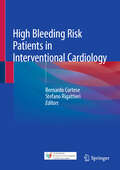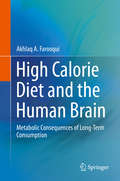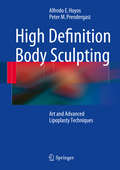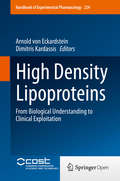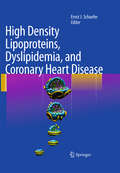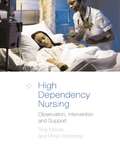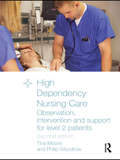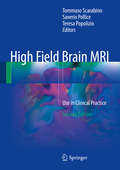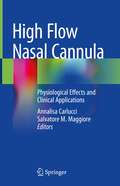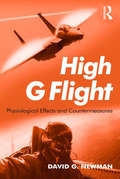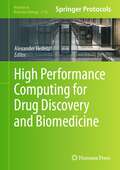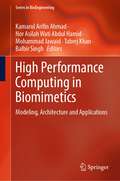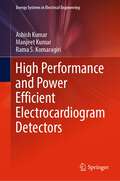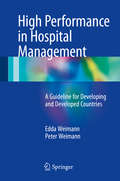- Table View
- List View
Hidden Hunger: Gender and the Politics of Smarter Foods
by Aya Hirata KimuraFor decades, NGOs targeting world hunger focused on ensuring that adequate quantities of food were being sent to those in need. In the 1990s, the international food policy community turned its focus to the "hidden hunger" of micronutrient deficiencies, a problem that resulted in two scientific solutions: fortification, the addition of nutrients to processed foods, and biofortification, the modification of crops to produce more nutritious yields. This hidden hunger was presented as a scientific problem to be solved by "experts" and scientifically engineered smart foods rather than through local knowledge, which was deemed unscientific and, hence, irrelevant. In Hidden Hunger, Aya Hirata Kimura explores this recent emphasis on micronutrients and smart foods within the international development community and, in particular, how the voices of women were silenced despite their expertise in food purchasing and preparation. Kimura grounds her analysis in case studies of attempts to enrich and market three basic foods-rice, wheat flour, and baby food-in Indonesia. She shows the power of nutritionism and how its technical focus enhanced the power of corporations as a government partner while restricting public participation in the making of policy for public health and food. She also analyzes the role of advertising to promote fortified foodstuffs and traces the history of Golden Rice, a crop genetically engineered to alleviate vitamin A deficiencies. Situating the recent turn to smart food in Indonesia and elsewhere as part of a long history of technical attempts to solve the Third World food problem, Kimura deftly analyzes the intersection of scientific expertise, market forces, and gendered knowledge to illuminate how hidden hunger ultimately defined women as victims rather than as active agents.
Hidden Pathways to Extinction (Fascinating Life Sciences)
by Giovanni StronaThis book provides, for the first time, a comprehensive overview of the fundamental roles that ecological interactions play in extinction processes, bringing to light an underground of hidden pathways leading to the same dark place: biodiversity loss.We are in the midst of the sixth mass extinction. We see species declining and vanishing one after another. Poached rhinos, dolphins and whales slaughtered, pandas surviving only in captivity are strong emotional testimonials of what is happening. Yet, the main threat to natural communities may be overshadowed by the disappearance of large species, with most extinctions happening unnoticed and involving less eye-catching organisms, such as parasites and pollinators. Ecosystems hide countless, invisible wires connecting organisms in dense networks of ecological interactions. Through these networks, perturbations can propagate from one species to another, producing unpredictable effects. In worst case scenarios, the loss of one species might doom many others to extinction. Ecologists now consider such mechanisms as a fundamental – and still poorly understood - driver of the ongoing biodiversity crisis. Hidden Pathways to Extinction makes the invisible links connecting the fates of species and organisms evident, exploring why complexity can enhance ecosystem stability and yet accelerate species loss. Page after page, Strona provides convincing evidence that we are primarily responsible for the fall in biodiversity, that we are falling too, and that we need to redouble our conservation efforts now, or it won't be long before we hit the ground.
Hidden Valley Road
by Robert Kolker12 children.6 of them diagnosed with schizophrenia.Science's greatest hope in understanding the disease.___________*ONE OF BARACK OBAMA'S FAVOURITE BOOKS OF 2020**TIME 100 Must-Read Books Of 2020 Pick**New York Times bestseller**Selected as Oprah's Book Club Pick*'Startlingly intimate' - The Sunday Times'Grippingly told and brilliantly reported' - Mail on Sunday'Unforgettable' - The TimesFor fans of Educated, The Immortal Life of Henrietta Lacks and Three Identical StrangersDon and Mimi Galvin seemed to be living the American dream. After World War II, Don's work with the Air Force brought them to Colorado, where their twelve children perfectly spanned the baby boom: the oldest born in 1945, the youngest in 1965. In those years, there was an established script for a family like the Galvins - aspiration, hard work, upward mobility, domestic harmony - and they worked hard to play their parts. But behind the scenes was a different story: psychological breakdown, sudden shocking violence, hidden abuse. By the mid-1970s, six of the ten Galvin boys, one after the other, were diagnosed as schizophrenic. How could all this happen to one family?What took place inside the house on Hidden Valley Road was so extraordinary that the Galvins became one of the first families to be studied by the National Institutes of Mental Health. Their story offers a shadow history of the science of schizophrenia, from the era of institutionalization, lobotomy, and the schizophrenogenic mother, to the search for genetic markers for the disease, always amidst profound disagreements about the nature of the illness itself. And unbeknownst to the Galvins, samples of their DNA informed decades of genetic research that continues today, offering paths to treatment, prediction, and even eradication of the disease for future generations.With clarity and compassion, bestselling and award-winning author Robert Kolker uncovers one family's unforgettable legacy of suffering, love and hope.'An extraordinary case study and tour de force of reporting' - Sylvia Nasar, author of A Beautiful Mind'This book tore my heart out. It is a revelation-about the history of mental health treatment, about trauma, foremost about family-and a more-than-worthy follow-up to Robert Kolker's brilliant Lost Girls' -Megan Abbott, Edgar Award-winning author of Dare Me and Give Me Your Hand'Hidden Valley Road contains everything: scientific intrigue, meticulous reporting, startling revelations, and, most of all, a profound sense of humanity. It is that rare book that can be read again and again'-David Grann, author of Killers of the Flower Moon
Hidden Valley Road
by Robert Kolker12 children.6 of them diagnosed with schizophrenia.Science's greatest hope in understanding the disease.___________*ONE OF BARACK OBAMA'S FAVOURITE BOOKS OF 2020**TIME 100 Must-Read Books Of 2020 Pick**New York Times bestseller**Selected as Oprah's Book Club Pick*'Startlingly intimate' - The Sunday Times'Grippingly told and brilliantly reported' - Mail on Sunday'Unforgettable' - The TimesFor fans of Educated, The Immortal Life of Henrietta Lacks and Three Identical StrangersDon and Mimi Galvin seemed to be living the American dream. After World War II, Don's work with the Air Force brought them to Colorado, where their twelve children perfectly spanned the baby boom: the oldest born in 1945, the youngest in 1965. In those years, there was an established script for a family like the Galvins - aspiration, hard work, upward mobility, domestic harmony - and they worked hard to play their parts. But behind the scenes was a different story: psychological breakdown, sudden shocking violence, hidden abuse. By the mid-1970s, six of the ten Galvin boys, one after the other, were diagnosed as schizophrenic. How could all this happen to one family?What took place inside the house on Hidden Valley Road was so extraordinary that the Galvins became one of the first families to be studied by the National Institutes of Mental Health. Their story offers a shadow history of the science of schizophrenia, from the era of institutionalization, lobotomy, and the schizophrenogenic mother, to the search for genetic markers for the disease, always amidst profound disagreements about the nature of the illness itself. And unbeknownst to the Galvins, samples of their DNA informed decades of genetic research that continues today, offering paths to treatment, prediction, and even eradication of the disease for future generations.With clarity and compassion, bestselling and award-winning author Robert Kolker uncovers one family's unforgettable legacy of suffering, love and hope.'An extraordinary case study and tour de force of reporting' - Sylvia Nasar, author of A Beautiful Mind'This book tore my heart out. It is a revelation-about the history of mental health treatment, about trauma, foremost about family-and a more-than-worthy follow-up to Robert Kolker's brilliant Lost Girls'-Megan Abbott, Edgar Award-winning author of Dare Me and Give Me Your Hand'Hidden Valley Road contains everything: scientific intrigue, meticulous reporting, startling revelations, and, most of all, a profound sense of humanity. It is that rare book that can be read again and again'-David Grann, author of Killers of the Flower Moon(P)2020 Penguin Audio
Hidden Valley Road: Inside the Mind of an American Family
by Robert KolkerThe heartrending story of a mid-century American family with twelve children, six of them diagnosed with schizophrenia, that became science's great hope in the quest to understand--even cure--the disease.Don and Mimi Galvin seemed to be living the dream. After World War II, Don's work with the US Air Force brought them to Colorado, where their twelve children perfectly spanned the baby boom: the oldest born in 1945, the youngest in 1965. In those years there was an established script for a family like the Galvins--aspiration, hard work, upward mobility, domestic harmony--and they worked hard to play their parts. But behind the scenes was a different story: psychological breakdown, sudden shocking violence, hidden abuse. By the mid-1970s, six of the ten Galvin boys were diagnosed as schizophrenic. How could all this happen in one family? What took place inside the house on Hidden Valley Road was so extraordinary that the Galvins became one of the first families to be studied by the National Institutes of Mental Health. Their shocking story also offers a shadow history of the science of schizophrenia, from the era of institutionalization, lobotomy and the premise of the schizophrenogenic mother, to the search for genetic markers for the disease, always amidst profound disagreements about the nature of the illness itself. Unknown to the Galvins, samples of their DNA informed decades of genetic research that continues today, offering paths to treatment and even the possibility of the eradication of the disease for future generations. With clarity and compassion, bestselling and award-winning author Robert Kolker uncovers one family's unforgettable legacy of suffering, love and hope.
Hidden Valley Road: Inside the Mind of an American Family
by Robert Kolker#1 NEW YORK TIMES BESTSELLER • OPRAH&’S BOOK CLUB PICK • ONE OF GQ's TOP 50 BOOKS OF LITERARY JOURNALISM IN THE 21st CENTURY • The heartrending story of a midcentury American family with twelve children, six of them diagnosed with schizophrenia, that became science's great hope in the quest to understand the disease. "Reads like a medical detective journey and sheds light on a topic so many of us face: mental illness." —Oprah WinfreyDon and Mimi Galvin seemed to be living the American dream. After World War II, Don's work with the Air Force brought them to Colorado, where their twelve children perfectly spanned the baby boom: the oldest born in 1945, the youngest in 1965. In those years, there was an established script for a family like the Galvins--aspiration, hard work, upward mobility, domestic harmony--and they worked hard to play their parts. But behind the scenes was a different story: psychological breakdown, sudden shocking violence, hidden abuse. By the mid-1970s, six of the ten Galvin boys, one after another, were diagnosed as schizophrenic. How could all this happen to one family?What took place inside the house on Hidden Valley Road was so extraordinary that the Galvins became one of the first families to be studied by the National Institute of Mental Health. Their story offers a shadow history of the science of schizophrenia, from the era of institutionalization, lobotomy, and the schizophrenogenic mother to the search for genetic markers for the disease, always amid profound disagreements about the nature of the illness itself. And unbeknownst to the Galvins, samples of their DNA informed decades of genetic research that continues today, offering paths to treatment, prediction, and even eradication of the disease for future generations.With clarity and compassion, bestselling and award-winning author Robert Kolker uncovers one family's unforgettable legacy of suffering, love, and hope.
Hidden and Lesser-known Disordered Eating Behaviors in Medical and Psychiatric Conditions
by Lorenzo Maria Donini Massimo Cuzzolaro Emilia ManzatoThis book provides up-to-date information on lesser known eating disorders (EDs) and eating related disorders. EDs and eating-related disorders include a highly heterogeneous group of syndromes and symptoms characterized by abnormal eating and weight control behaviors that can appear in all genders and ages. EDs can lead to high rates of morbidity and mortality, especially if they are misdiagnosed and untreated. The risk of underestimation is high for the lesser-known ED, and when unhealthy eating behaviors appear in unusual situations, such as some medical and psychiatric pathologies, adults and the elderly, sexual minorities etc. The volume examines EDs in specific populations (the elderly, males, infants and toddlers, sexual minorities, etc.). Several chapters explore in detail lesser-known EDs (anorexia athletica, avoidant/restrictive food intake disorder, chewing and spitting, EDs by proxy, EDs after bariatric surgery, muscle dysmorphia, night-eating syndrome, nocturnal sleep-related eating disorder, orthorexia nervosa, pica, rumination disorder, etc.). Finally, other chapters address features of unhealthy eating and weight control behaviors associated with medical diseases (achalasia, craniopharyngioma, cystic fibrosis, cyclic vomiting syndrome, diabetes, dysphagia, Kleine-Levin syndrome, Klinefelter syndrome, Parkinson disease, Prader-Willi syndrome, Turner syndrome, etc.) The book will be a valuable resource for all health professionals who work in the fields of psychiatry, clinical psychology, eating disorders, obesity, medicine, clinical nutrition, public health, and prevention, allowing them to broaden their understanding of these disorders, and to enhance their clinical ability to diagnose them.
Hidradenitis Suppurativa: A Diagnostic Atlas
by Giuseppe MicaliHidradenitis Suppurativa: A Diagnostic Atlas provides a unique visual aid to the diagnosis of Hidradenitis Suppurativa (HS), also known as "acne inversa." The book covers the epidemiology and pathogenesis of the disease, its typical presentation, differences in manifestations of cutaneous versus systemic instances, and considerations for clinical and histopathological differential diagnosis. Guidance is also provided for the classification of disease severity and for managing the impact of HS on the patient's quality of life. The book is packed with high-quality, full-color clinical images for each of the most common HS diagnostic imaging techniques, such as videodermatoscopy, ultrasound, computed tomography, and magnetic resonance imaging. As a clinical atlas, it helps dermatologists with differential diagnoses and correct assessments of disease severity, as well as possible complications of the condition. The book: Is highly focused on acne inversa, which can have a debilitating impact on quality of life Includes over 200 outstanding diagnostic clinical images Covers all imaging modalities used in the diagnosis and management of Hidradenitis Suppurativa This book is a key resource for dermatologists, dermatopathologists, and dermatology nurses working with patients with HS.
High Altitude
by Erik R. Swenson Peter Bärtsch Over the last decade the science and medicine of high altitude and hypoxia adaptation has seen great advances. High Altitude: Human Adaptation to Hypoxia addresses the challenges in dealing with the changes in human physiology and the particular medical conditions that arise from exposure to high altitude. In-depth and comprehensive chapters cover both the basic science and the clinical consequences of exposure to high altitude. Genetic, cellular, organ and whole body system responses to high altitudes are covered and chapters discuss these effects on a wide range of diseases. Expert authors provide insight into the care of patients with pre-existing medical conditions that fail in some cases to adapt as well as offer insights into how high altitude research can help critically ill patients. High Altitude: Human Adaptation to Hypoxia is an important new volume that offers a window into greater understanding and more successful treatment of hypoxic human diseases.
High Altitude Medicine: A Case-Based Approach
by Jorge Hidalgo Sabrina Da Re António Gandra D’AlmeidaHigh-altitude illness is a collective term for a cluster of acute clinical syndromes that directly consequence from rapid ascent to high altitude, viz., above 2500 m. The acute syndromes affecting the brain include acute mountain sickness (AMS) and high-altitude cerebral edema (HACE). The current practice of high altitude medicine requires a deep knowledge of existing evidence. However, knowledge of the field is continuously evolving, and there are many gaps in the existing literature as well as areas of controversy despite existing research in the area. Each chapter begins with a real case from the author's clinical practice. After each case, a question is asked to allow the reader to reflect on clinical management before reading the answer and consolidating knowledge from experts in the field. They also focus on the standard practice of management and diagnosis, emphasizing evidence-based care when available as well as areas of uncertainty and active debate in the medical literature.Written by experts in the field, High Altitude Medicine offers the most up-to-date knowledge about high altitude medicine that is not only useful for physicians at high altitude dedicated centers but also medical providers at different levels of their careers, especially emergency and urgent care physicians who are the ones that initially see the patient.
High Altitude Sickness – Solutions from Genomics, Proteomics and Antioxidant Interventions
by Narendra Kumar Sharma Aditya AryaThis book reviews the recent advances in the development of proteomics-based biomarkers for the non-invasive diagnosis of altitude sickness and explores the potential of antioxidant therapy for this sickness. The first chapters introduce the associated pathophysiology and provide mechanistic insights into the enhanced generation of reactive oxygen and nitrogen species (RONS), which leads to an increase in oxidative damage to lipids, proteins, and DNA. The book then highlights the current problems relating to the diagnosis and treatment of altitude sickness and summarizes novel approaches for identifying potential biomarkers and therapeutics. Lastly, it explores the therapeutic efficacy of antioxidant agents.
High Bleeding Risk Patients in Interventional Cardiology
by Bernardo Cortese Stefano RigattieriThis book will cover all areas concerning the high bleeding risk and fragile patients (including CHIP). This milieu is becoming more and more common and requires specific attention and investment from the healthcare systems to be managed properly. The book will be divided into 4 macro-areas (coronary artery disease, valvular heart disease, peripheral arterial disease, high thrombotic risk patients), each of which include specific chapters on the latest technical advances, offering a thorough literature coverage as well. Additional sections are devoted to future diagnostic and therapeutic areas, depending on the disease and the patient's risk profile. Interventional cardiologists and cardiac surgeons dealing with PCI, coronary bypasses, left atrial appendage closure, aortic and mitral interventions in this patient subgroup will be provided with an overview of the latest techniques and innovative technologies in this area, that will help them improving the clinical outcome of their patients. The invited group of collaborators was selected from among the most experienced physicians in the world, from Asia, North and South America and Europe.
High Calorie Diet and the Human Brain
by Akhlaq A. FarooquiThe purpose of this monograph is to present readers with a comprehensive and cutting edge description of neurochemical effects of diet (beneficial and harmful effects) in normal human brain and to discuss how present day diet promotes pathogenesis of stroke, AD, PD, and depression in a manner that is useful not only to students and teachers but also to researchers, dietitians, nutritionists and physicians. A diet in sufficient amount and appropriate macronutrients is essential for optimal health of human body tissues. In brain, over-nutrition, particularly with high-calorie diet, not only alters cellular homeostasis, but also results in changes in the intensity of signal transduction processes in reward centers of the brain resulting in food addiction. Over-nutrition produces detrimental effects on human health in general and brain health in particular because it chronically increases the systemic and brain inflammation and oxidative stress along with induction of insulin resistance and leptin resistance in the brain as well as visceral organs. Onset of chronic inflammation and oxidative stress not only leads to obesity and heart disease, but also promotes type II diabetes and metabolic syndrome, which are risk factors for both acute neural trauma (stroke) and chronic age-related neurodegenerative and neuropsychological disorders, such as Alzheimer disease (AD), Parkinson disease (PD) and depression.
High Definition Body Sculpting
by Alfredo E. Hoyos Peter M. PrendergastThis unique book details advanced techniques in lipoplasty and autologous fat grafting for high-definition body sculpting. Clear step-by-step explanations of techniques are accompanied by numerous color illustrations and photographs. The first section includes chapters on surface and muscular anatomy, anesthesia, assessment, technologies for ultrasound-assisted lipoplasty, and postoperative care High-definition sculpting of the male and female abdomen, trunk, back, chest, and upper and lower limbs is then described in detail, and clear instruction is provided on autologous fat grafting for contouring the buttocks, breasts, and pectoral areas. The book will provide a fascinating insight into the art and practice of high-definition body sculpting for all surgeons who perform lipoplasty and body contouring techniques It will also serve as an ideal aid for all practitioners who are pursuing workshops and practical training in this exciting new area of aesthetic surgery.
High Density Lipoproteins
by Arnold Von Eckardstein Dimitris KardassisIn this Handbook of Experimental Pharmacology on "High Density Lipoproteins - from biological understanding to clinical exploitation" contributing authors (members of COST Action BM0904/HDLnet) summarize in more than 20 chapters our current knowledge on the structure, function, metabolism and regulation of HDL in health and several diseases as well as the status of past and ongoing attempts of therapeutic exploitation. The book is of interest to researchers in academia and industry focusing on lipoprotein metabolism, cardiovascular diseases and immunology as well as clinical pharmacologists, cardiologists, diabetologists, nephrologists and other clinicians interested in metabolic or inflammatory diseases.
High Density Lipoproteins, Dyslipidemia, and Coronary Heart Disease
by Ernst J. SchaeferThis innovative atlas focuses on HDL and its relationships to triglyceride-rich particles. As new therapies for HDL raising become available, a comprehensive understanding the role of HDL in Coronary Heart Disease of great importance. This atlas is an excellent resource for educating physicians and scientists about dyslipidemia and HDL metabolism, including many exogenous substances which interact with and influence HDL. Readers will benefit from the unique visual exposition and the insights of international experts.
High Dependency Nursing Care: Observation, Intervention and Support for Level 2 Patients
by Philip Woodrow Tina MooreWritten by a team of nurses experienced in providing, supporting and developing high dependency care, this book discusses practical issues and explores the current evidence base for clinical practice. It covers all important skills needed and best practice for caring for high dependency patients or undertaking post registration courses to prepare them for high dependency nursing. Structured in four parts, the first, ‘Perspectives on High Dependency Care’ explores the contest of care, focusing on fundamental aspects like sleep, nutrition, pain management and stress, demonstrating how to achieve quality nursing care. ‘Pathophysiology and Treatments’ describes the main diseases that cause critical illness and treatments that patients will often be given. ‘Monitoring and Skills’ enables nurses to interpret and understand the information gained from observation and monitoring. The final part, ‘Professional Issues’ explores topics like clinical governance, reflection, practice development and managing change to assist nurses in developing their own clinical practice and professional development.
High Dependency Nursing Care: Observation, Intervention and Support for Level 2 Patients
by Philip Woodrow Tina MooreLevel 2 (highly dependent) patients are nursed in a variety of clinical areas. High Dependency Nursing Care has been written for pre qualified and post qualified students undertaking modules and placements to prepare them for nursing the acutely ill and nurses caring for these patients. Written by a team of nurses experienced in providing, supporting and developing high dependency care, it discusses practical issues and explores the current evidence base for clinical practice. This essential textbook covers the context of care with chapters on fundamental aspects, such as sleep, nutrition, pain management and stress. It goes on to look at the main causes of critical illness and the treatments often given, as well as the skills necessary for monitoring patients. Completely updated throughout, this second edition also includes new chapters on infection control, heart failure, tissue removal and transferring the sicker patient. High Dependency Nursing Care is: Comprehensive: it covers all the key areas of knowledge needed User-friendly: it includes learning outcomes, introductions, time out exercises, implications for practice, useful websites and up-to-date references Clearly written: by a team of experienced nurses Practically based: clinical scenarios provide stimulating discussion and revision topics
High Field Brain MRI
by Tommaso Scarabino Saverio Pollice Teresa PopolizioThis book describes the development of systems of magnetic resonance imaging using the higher magnetic field strength of 3 tesla, in comparison to the current gold standard of 1. 5 tesla. These new systems of MRI make it possible to perform with high spatial, temporal and contrast resolution not only morphological examinations but also functional studies on spectroscopy, diffusion, perfusion, and cortical activation, thus helping research and providing an important tool for routine diagnostic activity. At the same time the new systems offer unparalleled sensitivity and specificity in the numerous conditions of neuroradiological interest.
High Flow Nasal Cannula: Physiological Effects and Clinical Applications
by Annalisa Carlucci Salvatore M. MaggioreThis book presents the state of the art in high-flow nasal cannula (HFNC), an oxygen therapy technique that has recently proven to be a very promising approach to supporting respiratory function in several medical fields.In the opening part of the book, readers will learn the differences between high-flow and low-flow techniques and gain an overview of HFNC’s technical aspects and physiological effects. The book subsequently describes the pathophysiological mechanisms involved in different respiratory diseases, analyzing how this technique positively impacts patients’ respiratory status. The authors highlight clinical applications of HFNC, both in adults and in children, in various clinical settings – e.g. intensive care and semi-intensive care unit, emergencies, rehabilitation etc. – and present tips, tricks and pitfalls, as well as up-to-date reports on technical issues. The book is intended for pneumologists, intensivists, anesthesiologists, ED doctors, rehabilitation therapists, internists and oncologists, as well as fellows and nurses in these fields.
High G Flight: Physiological Effects and Countermeasures
by David NewmanThis book provides a unique, authoritative and detailed examination of the physiological and clinical consequences of human exposure to high G forces. Pilots of military fast jets, civilian aerobatic pilots and astronauts during the launch and re-entry phases of spaceflight are frequently and repetitively exposed to high G forces, for which the human body is not fundamentally designed. The book examines not only the nature of the high G environment, but the physiological effects of exposure to high G on the various systems of the human body. In particular, the susceptibility of the human cardiovascular system to high G is considered in detail, since G-Induced Loss of Consciousness (G-LOC) is a serious hazard for high G pilots. Additionally, the factors that influence tolerance to G and the emerging scientific evidence of physiological adaptation to high G are examined, as are the various countermeasures and techniques that have been developed over the years to protect pilots from the potentially adverse consequences of high G flight, such as the G-suit and positive pressure breathing. The accumulated knowledge of human exposure to high G is drawn together within High G Flight, resulting in a definitive volume on the physiological effects of high G and their countermeasures.
High Performance Computing for Drug Discovery and Biomedicine (Methods in Molecular Biology #2716)
by Alexander HeifetzThis volume explores the application of high-performance computing (HPC) technologies to computational drug discovery (CDD) and biomedicine. The first section collects CDD approaches that, together with HPC, can revolutionize and automate drug discovery process, such as knowledge graphs, natural language processing (NLP), Bayesian optimization, automated virtual screening platforms, alchemical free energy workflows, fragment-molecular orbitals (FMO), HPC-adapted molecular dynamic simulation (MD-HPC), and the potential of cloud computing for drug discovery. The second section delves into computational algorithms and workflows for biomedicine, featuring an HPC framework to assess drug-induced arrhythmic risk, digital patient applications relevant to the clinic, virtual human simulations, cellular and whole-body blood flow modeling for stroke treatments, prediction of the femoral bone strength from CT data, and many more subjects. Written for the highly successful Methods in Molecular Biology series, chapters include introductions to their respective topics, lists of the necessary software and tools, step-by-step and readily reproducible modeling protocols, and tips on troubleshooting and avoiding known pitfalls. Authoritative and practical, High Performance Computing for Drug Discovery and Biomedicine allows a diverse audience, including computer scientists, computational and medicinal chemists, biologists, clinicians, pharmacologists and drug designers, to navigate the complex landscape of what is currently possible and to understand the challenges and future directions of HPC-based technologies.
High Performance Computing in Biomimetics: Modeling, Architecture and Applications (Series in BioEngineering)
by Mohammad Jawaid Tabrej Khan Kamarul Arifin Ahmad Balbir Singh Nor Asilah Wati Abdul HamidThis book gives a complete overview of current developments in the implementation of high performance computing (HPC) in various biomimetic technologies. The book presents various topics that are subdivided into the following parts: A) biomimetic models and mechanics; B) locomotion and computational methods; C) distributed computing and its evolution; D) distributed and parallel computing architecture; E) high performance computing and biomimetics; F) big data, management, and visualization; and G) future of high performance computing in biomimetics. This book presents diverse computational technologies to model and replicate biologically inspired design for the purpose of solving complex human problems. The content of this book is presented in a simple and lucid style which can also be used by professionals, non-professionals, scientists, and students who are interested in the research area of high performance computing applications in the development of biomimetics technologies.
High Performance and Power Efficient Electrocardiogram Detectors (Energy Systems in Electrical Engineering)
by Ashish Kumar Manjeet Kumar Rama S. KomaragiriThis book details the characteristics of an ECG signal through the functionality and electrical activity of the human heart. This book provides a basic introduction and needs for developing implantable cardiac pacemaker systems. This book provides comprehensive details on ECG signal processing techniques that are useful for fast and accurate diagnosis of cardiovascular diseases. The book discusses the characteristics and parameters of a typical ECG signal and various noises that can corrupt an ECG signal. It also covers various challenges involved in different stages of signal acquisition, preprocessing, and detection of an ECG signal. The book also presents a detailed survey of various ECG signal detection and data compression techniques. The book contains detailed information on ECG signals and various noises that corrupt an ECG signal. It also includes de-noising techniques, ECG peak detection techniques, and ECG data compression techniques. It also includes step-by-step details to design various filters in MATLAB. This book, through detailed explanations, provides the reader with necessary information on ECG signal, ECG signal acquisition process, noise removal techniques, and the detection of ECG peaks.
High Performance in Hospital Management
by Edda Weimann Peter WeimannThisbook provides a broad overview of what is needed to run hospitals and otherhealth care facilities effectively and efficiently. All of the skills and toolsrequired to achieve this aim are elucidated in the book, including businessengineering and change management, strategic planning and the Balanced Scorecard,project management, integrative innovation management, social and ethical aspectsof human resource management, communication and conflict management, staffdevelopment and leadership. The guidance offered is exceptional and applicable inboth developed and developing countries. Furthermore, the relevant theoretical backgroundis outlined and instructive case reports are included. Each chapter finishes witha summary and five reflective questions. Excellence can only be achieved when healthcare professionals show in addition to their medical skills a high level ofmanagerial competence. High performance in Hospital Management assists managersof health care providers as well as doctors and nurses to engage in thesuccessful management of a health care facility.
